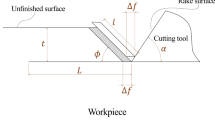Abstract
Surface quality deterioration is prone to be found in Inconel-718 milling process, which leads to the decrease of fatigue life of aerospace critical safety components. Therefore, in-process detection of surface quality plays an important role in guaranteeing the workpiece quality and improving the production efficiency. In this paper, a surface quality monitoring system based on time-frequency features of acoustic emission signals is established. The main characteristic of this system is that a two-step recognition is performed through the binary clustering to realize the monitoring of surface roughness and the precise recognition of the surface defects, respectively. A new feature extraction method by means of the normalized time-frequency matrix is proposed to obtain the sensitive information of surface quality. In addition, to accomplish the clustering automatically, the improved method of clustering by fast search and find of density peaks is utilized. The experimental verification with different cutting depth is designed to test the effectiveness of the system. Validation results show that the accuracy of the two steps are 99 and 72%, respectively.
Similar content being viewed by others
References
Zhou JM, Bushlya V, Stahl JE (2012) An investigation of surface damage in the high speed turning of Inconel 718 with use of whisker reinforced ceramic tools. J Mater Process Technol 212(2):372–384
Huang Q, Ren JX (1991) Surface integrity and its effects on the fatigue life of the nickel-based superalloy GH33A. Int J Fatigue 13(4):322–326
Thakur A, Gangopadhyay S (2016) State-of-the-art in surface integrity in machining of nickel-based super alloys. Int J Mach Tool Manu 100:25–54
Zeng W, Jiang X, Blunt L (2009) Surface characterisation-based tool wear monitoring in peripheral milling. Int J Adv Manuf Technol 40(3–4):226–233
Ren Q, Balazinski M, Baron L et al (2014) Type-2 fuzzy tool condition monitoring system based on acoustic emission in micromilling. Inf Sci 255(1):121–134
Pawade RS, Joshi SS, Brahmankar PK et al (2007) An investigation of cutting forces and surface damage in high-speed turning of Inconel 718. J Mater Process Technol 192–193(10):139–146
Somkiat T, Somchart A, Sirichan T (2010) In-process monitoring and prediction of surface roughness on CNC turning by using response surface analysis. In: Hinduja S., Li L (eds) Proceedings of the 36th International MATADOR Conference. Springer, London, 2010:213-216. DOI: https://doi.org/10.1007/978-1-84996-432-6_49
Khorasani A, Yazdi MRS (2017) Development of a dynamic surface roughness monitoring system based on artificial neural networks (ANN) in milling operation. Int J Adv Manuf Technol 93:141–151
Quintana G, Garcia-Romeu ML, Ciurana J (2011) Surface roughness monitoring application based on artificial neural networks for ball-end milling operations. J Intell Manuf 22(4):607–617
Plaza EG, López PJN (2018) Application of the wavelet packet transform to vibration signals for surface roughness monitoring in CNC turning operations. Mech Syst Signal Process 98:902–919
Plaza EG, López PJN (2018) Analysis of cutting force signals by wavelet packet transform for surface roughness monitoring in CNC turning. Mech Syst Signal Process 98:634–651
Huang PB, Zhang HJ, Lin YC (2017) Development of a Grey online modeling surface roughness monitoring system in end milling operations. J Intell Manuf. https://doi.org/10.1007/s10845-017-1361-z
Beggan C, Woulfe M, Young P, Byrne G (1999) Using acoustic emission to predict surface quality. Int J Adv Manuf Technol 15(10):737–742
Pawade RS, Joshi SS (2012) Analysis of acoustic emission signals and surface integrity in the high-speed turning of Inconel 718. Proc Inst Mech Eng B J Eng 226(1):3–27
Axinte D (2004) Process monitoring to assist the workpiece surface quality in machining. Int J Mach Tool Manu 44(10):1091–1108
Marinescu I, Axinte DA (2008) A critical analysis of effectiveness of acoustic emission signals to detect tool and workpiece malfunctions in milling operations. Int J Mach Tool Manu 48(10):1148–1160
Marinescu I, Axinte D (2009) A time–frequency acoustic emission-based monitoring technique to identify workpiece surface malfunctions in milling with multiple teeth cutting simultaneously. Int J Mach Tool Manu 49(1):53–65
Li W, Guo YB, Barkey ME, Jordon JB (2014) Effect tool wear during end milling on the surface integrity and fatigue life of Inconel 718. Procedia CIRP 14:546–551
Arunachalam RM, Mannan MA, Spowage AC (2004) Residual stress and surface roughness when facing age hardened Inconel 718 with CBN and ceramic cutting tools. Int J Mach Tool Manu 44(9):879–887
Rodriguez A, Laio A (2014) Machine learning. Clustering by fast search and find of density peaks. Science 344(6191):1492–1496
Wu M, Schölkopf B, (2007) A local learning approach for clustering. In: Schölkopf B, Platt J, Hofmann T (eds) Advances in neural information processing systems 19 (NIPS 2006). Vancouver 1:1529–1536
Funding
This project is supported by the National Natural Science Foundation of China (51675369), Tianjin Science and Technology Program (16PTSYJC00150), National Natural Science Foundation of China (51420105007), and National Science and Technology Major Projects (2014ZX04012014).
Author information
Authors and Affiliations
Corresponding author
Rights and permissions
About this article
Cite this article
Li, Z., Wang, G. & He, G. Surface quality monitoring based on time-frequency features of acoustic emission signals in end milling Inconel-718. Int J Adv Manuf Technol 96, 2725–2733 (2018). https://doi.org/10.1007/s00170-018-1773-8
Received:
Accepted:
Published:
Issue Date:
DOI: https://doi.org/10.1007/s00170-018-1773-8




